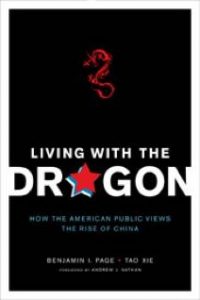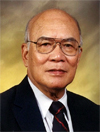
Reviewed by Stanton Jue
Living with the Dragon: How the American Public Views the Rise of China, Benjamin I. Page & Tao Xie, Columbia Univ. Press: New York, 2010, ISBN 978-0-231-15208-2 (cloth), 212 pp., $27.50
Living with the Dragon is a compact, cogent, and insightful volume to help American political leaders and the general public alike to understand the twists and turns of U. S.-China relations and China’s rapid rise in recent times. Professors Benjamin Page and Tao Xie researched and used an extensive collection of surveys conducted by various polling organizations to find the correlation between public opinion and China policy-making in Washington since the People’s Republic of China was established in 1949. The authors clearly reflect the mainstream views and interpretation of America’s policy of engagement, not confrontation, with China.
This book contains 121 pages of textual materials in six chapters, with extensive statistics, percentages, major surveys, graphics, and footnotes to present a comprehensive picture of how the American public views China’s rapid rise, which is in the opinion of many analysts the most important bilateral relationship in the world today.
Chapter 1 interprets the survey data to delineate the relationship between public opinion and U.S. China policy. Chapter 2 addresses the economic rise. Chapter 3 describes the rise of China as a global player in various fields. Chapter 4 delves into human rights and democracy issues. Chapter 5 investigates American perception of a rising China as friend or enemy. And Chapter 6 looks into the future to highlight some risks and opportunities.
For a period of time following China’s reemergence from self-imposed isolation, there was much ignorance and misinformation about each other by both China and the United States. Chinese military leaders and academics often described U.S. policy and intentions as conspiratorial to contain China as illustrated by forming military alliances with countries in China’s periphery, continuing arms sales to Taiwan, supporting Tibetan and Uighur dissidents, and conducting other activities blatantly interfering in China’s internal affairs. On the other hand, American public opinion toward China followed the ebb and flow of events but for most part was moderate and measured, even though a small number viewed China as an enemy or potential enemy.
As public opinion data illustrate, the dramatic rise of China has caused unease and anxiety among people in the United States and in other countries. Unclear of China’s ambitions, they are wary and unsure whether a rising China is an enemy threatening American interests or a friendly, peaceful, constructive, cooperative player in the community of nations.
No one really knows the answer, as American attitude toward China varies according to evolving events and circumstances. In my view, China is neither a friend nor enemy. Each country has its core interests and values. Because of differences in history, cultural and traditions, both countries naturally see things from a different perspective. Yet, it is not surprising to see a large gap of mutual trust between the two nations, reflecting the metaphor of a Chinese proverb “same bed, different dreams” referring to the dilemma of an odd couple’s goals. Some critics say what holds them together is expedience, not goals.
In an address to an audience of high-ranking Chinese and American policy makers at the first restructured Strategic and Economic Dialogue (S&ED) in Washington in July 2009, President Barack Obama aptly expressed his own strategic vision towards this bilateral relationship:
“Some in China think that America will try to contain China’s ambitions; some in America think that there is something to fear in a rising China. I take a different view.
I believe in a future where China is a strong, prosperous and successful member of the community of nations, a future where our nations are partners out of necessity, but also out of opportunity.”
Given the gargantuan fiscal crisis and political paralysis facing Washington, a confrontation policy clearly is not an attractive or sustainable strategy for the U.S. Today China holds a major portion of the U.S. national debt and that bilateral trade has reached the level of well over $400 billion today from $2.5 billion at the time of establishment of diplomatic relations with China in 1979. China enjoys a near 5 to 1 advantage. China has also accumulated more than $2.5 trillion in foreign exchange reserves from trade. Wal-Mart alone would be China’s 7th largest trade partner if it were a country instead of a company. The broad range of other intertwined activities demands a policy of peaceful and constructive engagement.
As a matter of fact, the U.S. government has followed the engagement track since Nixon’s visit to China in 1972, even though some of China’s actions, domestically and internationally, have created tensions and fear not only to people in the U.S. but in other countries as well. China is simply too big and too important a country for us not to have a policy which is flexible, agile, and adjustable.
The rationale for this strategy is based on three assumptive realities: 1) the traditional approach has not been particularly effective in altering Chinese policy or behavior, 2) the rapid expansion of Chinese global economic and political power requires the U.S. to reset foreign policy priorities, and 3) a belated recognition of the political environment calls for a softer rather than harsher approach to advance the shared interests of both countries in difficult economic times
Take the human rights and democracy issues which are essential elements of U.S. foreign policy. During Secretary Clinton’s maiden trip to China in February 2009, she discarded the business as usual approach to foreign policy by shifting the emphasis from human rights and human dignity and political freedoms to a new focus on global and regional political and economic issues. Her downplay of human rights and human dignity immediately stirred up consternation and outrage from human rights groups and politicians, even though she repeatedly reiterated no diminution of commitment to these issues in U.S. foreign policy. Nevertheless, critics called her approach weak and unhelpful to the cause.
To clarify her position, Clinton seemed to articulate a policy of “principled pragmatism” in a speech at Georgetown University last December, saying that “we must be pragmatic and agile in pursuit of our human rights agenda, not compromising on our principles, but doing what is most likely to make them real.” The aim, she added, is to make a difference, not to prove a point. As I see it, human rights and democracy must be addressed at appropriate time and circumstances with a deeper understanding of China’s domestic problems as well as our own problems.
In addition to human rights and democracy issues, let me add a few comments on risks and opportunities mentioned in the final chapter looking to the future. As Page pointed out, Taiwan is the most sensitive and troublesome issue. In the years when the Taipei government was under Democratic Progress Party (DPP) control, the island’s independence activists pushed the Taipei government to the brink of armed conflict on several occasions. However, when the Kuomintang (KMT) government regained power in 2008, political accommodation emerged as a policy of pragmatism prompting a flurry of activities across the Taiwan Strait in economics, cultural and family ties, not withstanding government standoff politically. An armed conflict across the Taiwan Strait has declined to a point that war is now extremely remote, but peaceful unification of the two sides is not an immediate or mid-term possibility either.
Competition for energy and resources is indeed a risk. China’s extensive investments in Latin America and Africa illustrate its aggressive policy to extract natural resources for its vast manufacturing sector. In the case of Brazil, for example, China in 2010 has replaced the U.S. as #1 trade partner, causing new concerns. Critics call China “new colonialists” fixating political as well as economic penetration in the region. Critics predict that rivalry between China and the U.S. is unavoidable, sooner or later.![]()

Stanton Jue is a retired U. S. Foreign Service Officer. He had postings in Cambodia, Taiwan, Japan, South Vietnam, South Korea, Australia, and China as well as an extended tour in Washington to help in the reopening of U. S. – China relations. His focus has been on China and U. S. relations with Beijing and Taipei. His articles on China affairs have appeared in the Foreign Service Journal, American Diplomacy, American Journal of Chinese Studies, among others.
